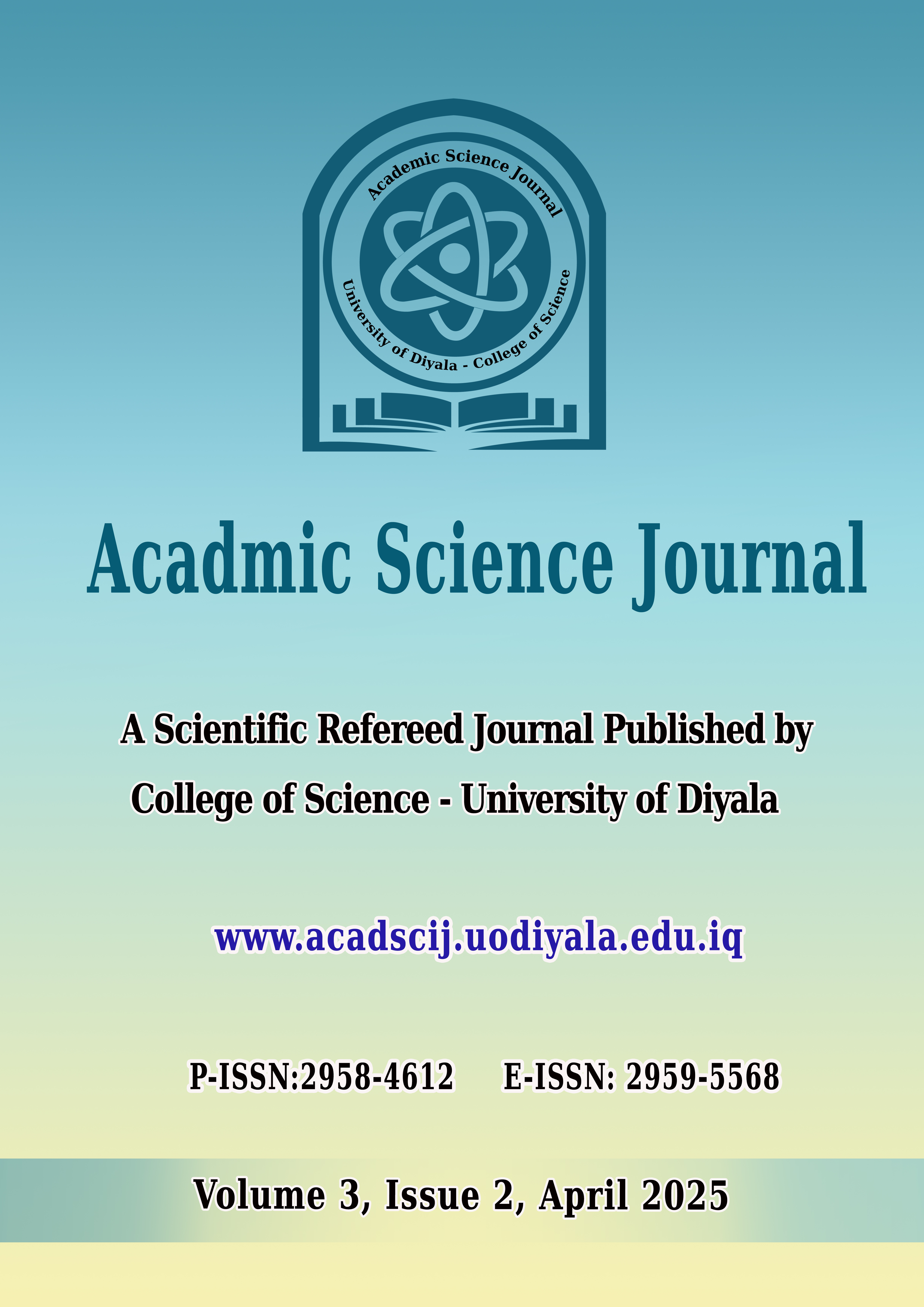Changes Detection Of Land Surface Temperature Over Southern Of Iraq During Period (1990 – 2022) Using Landsat Data
Changes Detection Of Land Surface Temperature Over Southern Of Iraq
DOI:
https://doi.org/10.24237/ASJ.03.02.886BKeywords:
Land surface temperature, Urban areas, Landsat, Remote sensing, GISAbstract
Land surface temperature (LST) is a crucial climate variable for climate change studies. It provides valuable data for understanding land surface conditions and land-atmosphere interactions. This study examines the spatial and temporal patterns of LST in Basra, Thi-Qar, and Maysan, three provinces in southern Iraq. Using Landsat 5 and 8 imagery from 1990, 2013, and 2022, we estimated LST for July (summer) and December (winter) of each year, employing ArcGIS 10.8. Supervised classification was used to categorize the spectral pixels of the LST into different ranges. The results show an increase in temperatures in July across the study area, notably in Basra and Zubair districts in Basra Governorate, most areas of Thi-Qar like Shatra, and parts of Maysan, which is considered humid due to existing marshes. In July, LST ranged from 23-58°C in Basra, 21-55°C in Thi-Qar, and 23-57°C in Maysan. In December, the LST ranged from 3-24°C in Basra, 3-28°C in Thi-Qar, and 4-23°C in Maysan. The findings indicate that LST values are mainly influenced by changes in land surface cover. From 1990 to 2022, there was a significant increase in LST across all cities, especially within the thermal range of 41-51°C in summer. Similarly, in December, there was a continuous increase in LST areas within the range of 16-22°C, with more pronounced increases observed in Basra and Maysan in 2022.
Downloads
References
. Yao et al., “A robust method for filling the gaps in MODIS and VIIRS land surface temperature data,” IEEE Trans. Geosci. Remote Sens., vol. 59, no. 12, pp. 10738–10752, 2021.
A. Bendib, H. Dridi, and M. I. Kalla, “Contribution of Landsat 8 data for the estimation of land surface temperature in Batna city, Eastern Algeria,” Geocarto Int., vol. 32, no. 5, pp. 503–513, 2017.
E. S. AL-Obaidey, “The study of NDVI fluctuation in southern Iraq (Hor Ibn Najim) using remote sensing data,” Al-Mustansiriyah J. Sci., vol. 30, no. 1, pp. 1–6, 2019.
J. A. Sobrino, J. C. Jiménez-Muñoz, and L. Paolini, “Land surface temperature retrieval from LANDSAT TM 5,” Remote Sens. Environ., vol. 90, no. 4, pp. 434–440, 2004.
E. Harash, K. Al-Tamimi, and S. Al-Timimi, “The relationship between government policy and financial performance: A study on the SMEs in Iraq,” China-USA Bus. Rev., vol. 13, no. 4, 2014.
Z. L. Kozina et al., “The influence of a special technique for developing coordination abilities on the level of technical preparedness and development of psycho-physiological functions of young volleyball players 14-16 years of age,” 2018.
H. O. Baram, O. A. Mohammed, H. K. Hamaamin, A. A. Hamid, and R. L. Mustafa, “Urbanization and its Effect on Land Surface Temperatures in Halabja City,” 2021.
D. X. Tran, F. Pla, P. Latorre-Carmona, S. W. Myint, M. Caetano, and H. V Kieu, “Characterizing the relationship between land use land cover change and land surface temperature,” ISPRS J. Photogramm. Remote Sens., vol. 124, pp. 119–132, 2017, doi: https://doi.org/10.1016/j.isprsjprs.2017.01.001.
B. Alahmad, L. P. Tomasso, A. Al-Hemoud, P. James, and P. Koutrakis, “Spatial distribution of land surface temperatures in Kuwait: urban heat and cool islands,” Int. J. Environ. Res. Public Health, vol. 17, no. 9, p. 2993, 2020.
O. Soydan, “Effects of landscape composition and patterns on land surface temperature: Urban heat island case study for Nigde, Turkey,” Urban Clim., vol. 34, p. 100688, 2020.
A.-A. Kafy et al., “Remote sensing approach to simulate the land use/land cover and seasonal land surface temperature change using machine learning algorithms in a fastest-growing megacity of Bangladesh,” Remote Sens. Appl. Soc. Environ., vol. 21, p. 100463, 2021.
A. Abulibdeh, “Analysis of urban heat island characteristics and mitigation strategies for eight arid and semi-arid gulf region cities,” Environ. Earth Sci., vol. 80, pp. 1–26, 2021.
A. Al-Yasiry, A. Allami, and A. Al Maliki, “Desertification Assessment for the Marshes Region Using Soil Quality Indicators, Southern Iraq,” Iraqi Geol. J., vol. 56, pp. 259–272, May 2023, doi: 10.46717/igj.56.1E.20ms-2023-5-30.
S. A. Saraskanrood, B. Asadi, and E. Ghale, “Land surface temperature assessment in relation to land-use/land-cover (A case study: Isfahan City, Central Iran),” Casp. J. Environ. Sci., vol. 21, no. 3, pp. 725–735, 2023.
K. Salman and B. A. Al Razaq, “Monitoring Land Surface Temperature (LST) and Land Cover of Basra Province using Remote Sensing Technique and GIS,” Iraqi J. Phys., vol. 21, no. 2, pp. 60–73, 2023.
K. H. A. Al-Aarajy and Z. H. M. Hassan, “Land Surface Temperature investigation of Babylon city between (2002-2022) using Remote Sensing and GIS Technique,” Iraqi J. Sci., 2023.
I. Felix, “A Multi-Layer Based Assessment of Wetland Changes in the Southern Iraqi Marshlands Using Remotely Sensed Data,” Ike, F. Ottah, CR A Multi-Layer Based Assess. Wetl. Chang. South. Iraqi Marshlands Using Remote. Sensed Data. Int. J. Geosci., vol. 10, pp. 801–810, 2019.
F. House, “Freedom in the World 2022-Iraq,” Civil Lib., vol. 13, p. 60, 2022.
B. M. Hashim, M. A. Sultan, M. N. Attyia, A. A. Al Maliki, and N. Al-Ansari, “Change detection and impact of climate changes to Iraqi southern marshes using Landsat 2 Mss, Landsat 8 Oli and sentinel 2 Msi data and Gis applications,” Appl. Sci., vol. 9, no. 10, p. 2016, 2019.
K. Khosravi et al., “Meteorological data mining and hybrid data-intelligence models for reference evaporation simulation: A case study in Iraq,” Comput. Electron. Agric., vol. 167, p. 105041, 2019.
A. M. Al-Lami, Y. K. Al-Timimi, and H. K. A. Al-Shamarti, “Spatiotemporal analysis of some extreme rainfall indices over Iraq (1981–2017),” Sci. Rev. Eng. Environ. Sci., vol. 30, no. 2, pp. 221–235, 2021.
R. N. Al-Malikey, B. M. Hashim, and S. A. Abduljabbar, “Using GIS to analyze some heavy metals concentrations in water of hammar, central and hawizeh marshes in southern Iraq,” Al-Mustansiriyah J. Sci, vol. 22, no. 6, 2011.
Downloads
Published
Issue
Section
License
Copyright (c) 2025 CC BY 4.0

This work is licensed under a Creative Commons Attribution 4.0 International License.





